The Seagate Enterprise Capacity 3.5" hard drive line is the newly rebranded family of high capacity hard drives of which the Constellation ES.3 is the newest member. The ES.3 is a 7,200 RPM, 3.5" enterprise hard drive with SAS or SATA 6Gb/s interface that’s offered in capacities up to 4TB. Seagate didn’t just bring a capacity bump to the line though. Compared to the prior generation Constellation ES.2, the ES.3 offers a sustained data rate of 175MB/s, up 13%, and Seagate has doubled the cache from 64MB in the ES.2 to 128MB in the ES.3.
The Constellation ES.3 is firmly targeted to enterprises who need large amounts of bulk storage with the reliability and performance benefits found in Seagate’s sixth generation enterprise high-capacity line. Further, with the SAS option in the ES.3, these drives are perfectly suited for storage arrays that offer high availability features. The drives are also tuned for enterprise workloads, making them more viable than consumer hard drives where some users have had to turn to up to this point to get 4TB capacities, albeit from a SATA interface only.
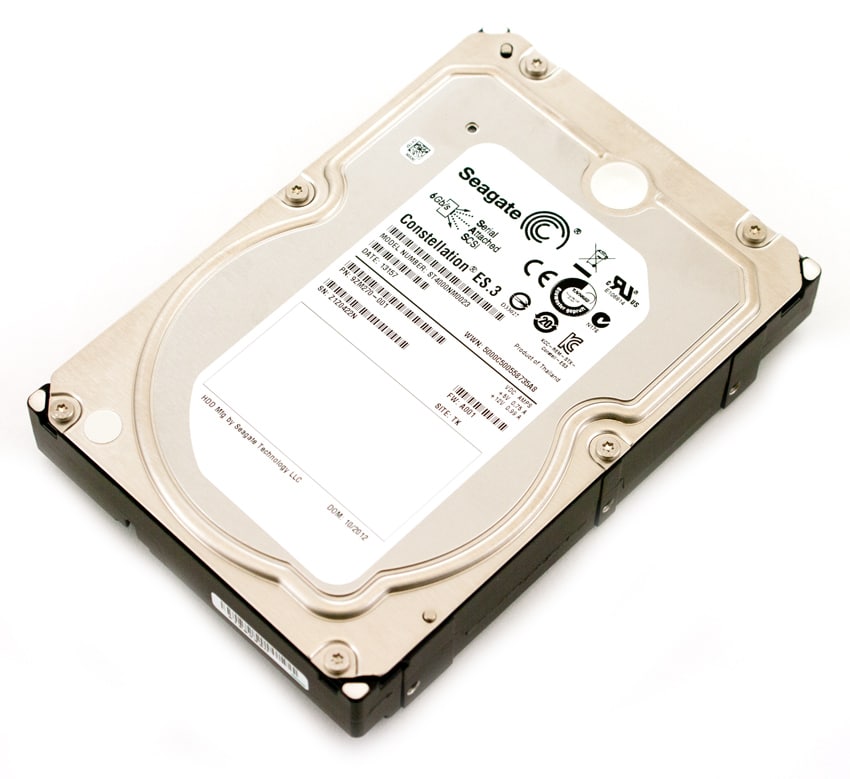
Seagate has made other progressive updates as well, like improved actuation move time which drives more IOPS at smaller queue depths. Power consumption has been dropped by 9% in idle when compared to the ES.2, MTBF has jumped from 1.2 million hours to 1.4 million and the load/unload cycles supported has doubled to 600,000. Seagate also touts features like the humidity sensor, thermal asperity selection, improved error correction and better data path protection on power loss.
Seagate offers the Constellation ES.3 in a variety of options. Both SATA and SAS versions come in 1TB, 2TB, 3TB and 4TB capacities. The SATA version comes in both standard and SED iterations, the SAS models also add a FIPS security option, which is currently exclusive to Seagate. The ES.3 comes with a 5-year warranty. Our review is of the 4TB SAS ES.3.
Seagate Constellation ES.3 Specifications (6Gb/s SAS)
- Capacities
- 1TB (2 disks, 3 heads)
- Standard (ST1000NM0023)
- SED (ST1000NM0043)
- SED-FIPS (ST1000NM0063)
- 2TB (3 disks, 5 heads)
- Standard (ST2000NM0023)
- SED (ST2000NM0043)
- SED-FIPS (ST2000NM0063)
- 3TB (4 disks, 8 heads)
- Standard (ST3000NM0023)
- SED (ST3000NM0043)
- SED-FIPS (ST3000NM0063)
- 4TB (5 disks, 10 heads)
- Standard (ST4000NM0023)
- SED (ST4000NM0043)
- SED-FIPS (ST4000NM0063)
- Spindle Speed (RPM): 7200
- Max. Sustained Transfer Rate OD (MB/s): 175
- Average Latency (ms): 4.16
- Cache: 128MB
- Interface Ports: Dual SAS 6Gb/s
- Rotation Vibration @ 1500 Hz (rad/s²) : 12.5
- Mean Time Between Failures (MTBF, hours): 1.4 million
- Reliability Rating @ Full 24×7 Operation (AFR): 0.63%
- Nonrecoverable Read Errors per Bits Read: 1 sector per 1015
- Power-On Hours per Year: 8760
- Bytes per Sector: 512, 520, 528
- Power Consumption:
- Idle Power (W)
- 4TB: 7.80
- 3TB: 6.74
- 2TB: 5.78
- 1TB: 4.84
- Typical Operating, Random Read (W)
- 4TB: 11.86
- 3TB: 10.72
- 2TB: 9.59
- 1TB: 8.93
- Idle Power (W)
- Temperature, Operating (°C): 5 to 60
- Vibration, Nonoperating: <5Hz to 500Hz (Gs): 0.25
- Shock, Operating, 2ms (Read/Write) (Gs): 70/40
- Shock, Nonoperating, 1ms and 2ms (Gs): 300
- Protection Information (T10 DIF): Yes
- Humdity Sensor: Yes
- Super Parity: Yes
- Low Halogen: Yes
- PowerChoice Technology: Yes
- Limited Warranty (years): 5
- 1TB (2 disks, 3 heads)
Build and Design
The Seagate Enterprise Capacity 3.5 HDD (Constellation ES.3) is a 3.5" LFF drive. Its external design is almost identical to the previous ES and ES.2 HDDs. Like previous models, it offers a SAS interface, with dual-6.0Gb/s connection.
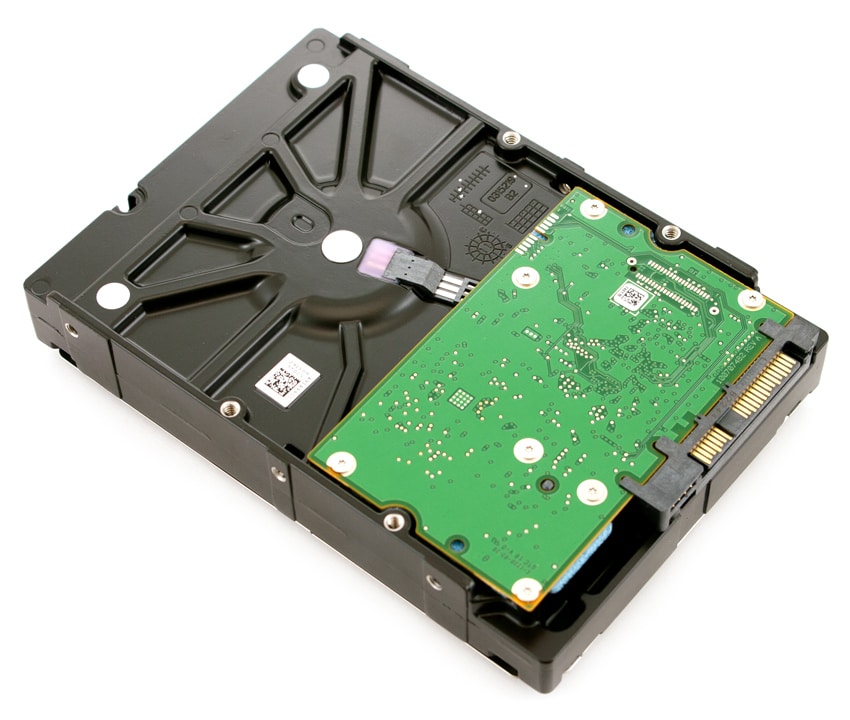
Removing the circuit board from the hard drive body, we find multiple thermal pads used to dissipate heat from certain components into the HDD body. This allows the drive to act as one large heatsink, bleeding off excess heat with normal server airflow.
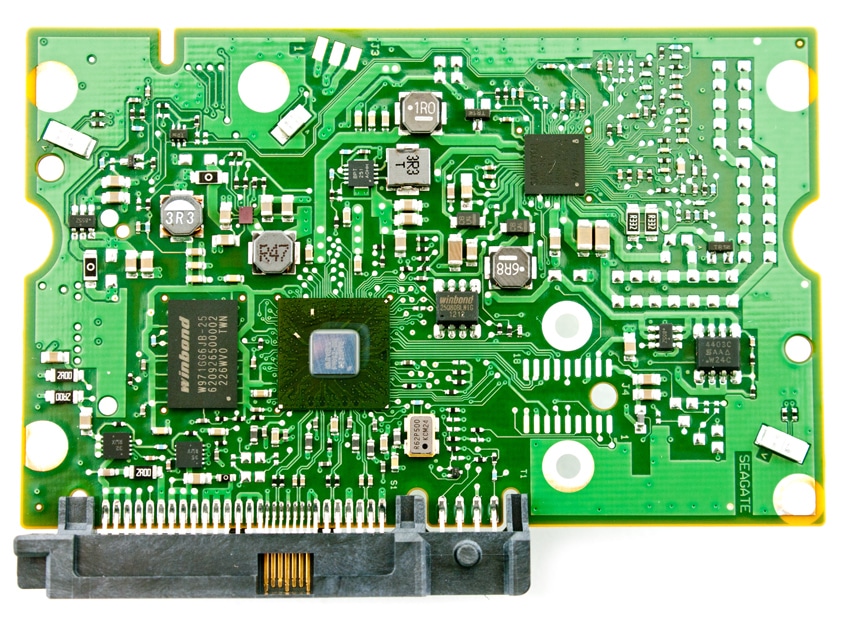
The Seagate Enterprise Capacity 3.5 HDD circuit board includes 128MB of on-board cache from a Windbond DDR2 module, a Marvell controller, and Smooth motor driver. The circuit board layout is such that all components are located on the inward-facing side, protecting them during installation and use.
Looking inside the 4TB Constellation sample we see the neatly configured platter and head configuration with the soft-ramp head loading mechanism on the top-right. In the photo below we see the side profile of the 5-platter, 10-head design unique to the 4TB model. The 3TB design utilizes a 4-platter and 8-head layout.
Testing Background and Comparables
7,200RPM Enterprise SAS HDD comparables for this review:
- Seagate Constellation ES 2TB
- Seagate Constellation ES.2 3TB
- Seagate Constellation ES.3 4TB
All enterprise HDDs are benchmarked on our enterprise testing platform based on a Lenovo ThinkServer RD240. The ThinkServer RD240 is configured with:
- 2 x Intel Xeon X5650 (2.66GHz, 12MB Cache)
- Windows Server 2008 Standard Edition R2 SP1 64-Bit and CentOS 6.2 64-Bit
- Intel 5500+ ICH10R Chipset
- Memory – 8GB (2 x 4GB) 1333Mhz DDR3 Registered RDIMMs
- LSI 9211 SAS/SATA 6.0Gb/s HBA
Enterprise Synthetic Workload Analysis
Our enterprise hard drive benchmark process preconditions each drive into steady-state with the same workload the device will be tested with under a heavy load of 16 threads with an outstanding queue of 16 per thread, and then tested in set intervals in multiple thread/queue depth profiles to show performance under light and heavy usage. Since hard drives reach their rated performance level very quickly, we only graph out the main sections of each test.
Preconditioning and Primary Steady-State Tests:
- Throughput (Read+Write IOPS Aggregate)
- Average Latency (Read+Write Latency Averaged Together)
- Max Latency (Peak Read or Write Latency)
- Latency Standard Deviation (Read+Write Standard Deviation Averaged Together)
Our Enterprise Synthetic Workload Analysis includes four profiles based on real-world tasks. These profiles have been developed to make it easier to compare to our past benchmarks as well as widely-published values such as max 4K read and write speed and 8K 70/30, which is commonly used for enterprise drives. We also included two legacy mixed workloads, the traditional File Server and Webserver, each offering a wide mix of transfer sizes.
- 4K
- 100% Read or 100% Write
- 100% 4K
- 8K 70/30
- 70% Read, 30% Write
- 100% 8K
- 128K
- 100% Read or 100% Write
- 100% 128K
- File Server
- 80% Read, 20% Write
- 10% 512b, 5% 1k, 5% 2k, 60% 4k, 2% 8k, 4% 16k, 4% 32k, 10% 64k
- Webserver
- 100% Read
- 22% 512b, 15% 1k, 8% 2k, 23% 4k, 15% 8k, 2% 16k, 6% 32k, 7% 64k, 1% 128k, 1% 512k
In our first workload with a 100% random 4K transfers, we measured 229 IOPS read from the Seagate Constellation ES.3 and 192 IOPS write. This was a steady improvement over both previous-generation models.
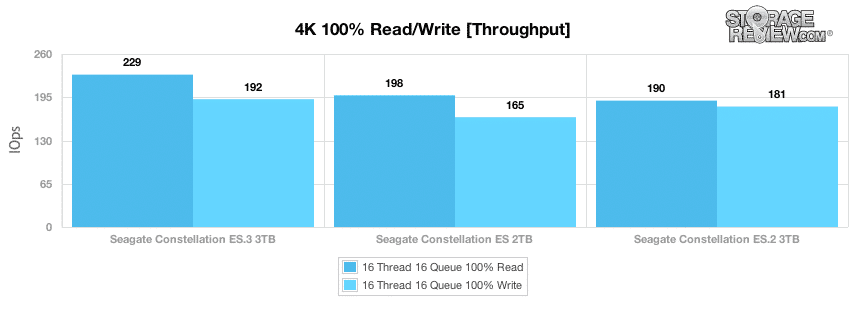
Average latency in our 100% random 4k test with a load of 16T/16Q measured 1,114ms read and 1,327ms write from the Constellation ES.3.
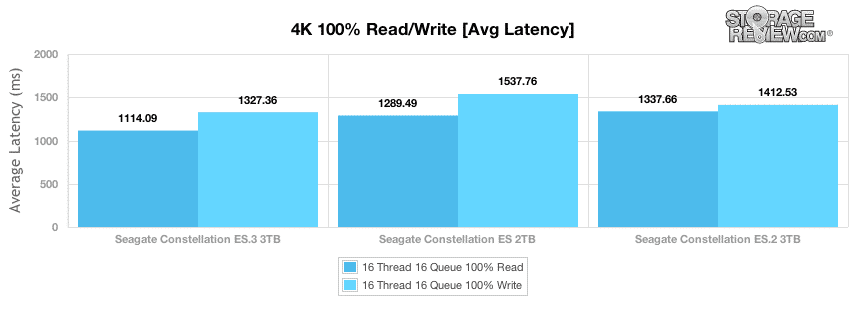
Comparing peak response times in our random 4K test, the Constellation ES.3 had the lowest read response times, but lost a bit of an edge in max write response times.
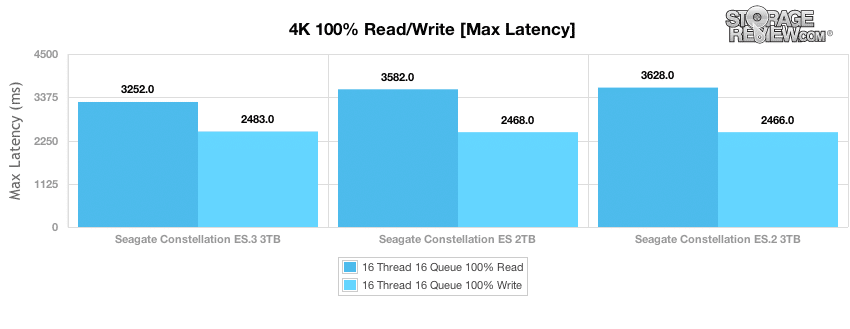
Comparing latency consistency between each drive in a 4K random workload in our latency standard deviation section, the ES.3 ranked middle of the board on read latency (ES having the lead) and best in write latency.
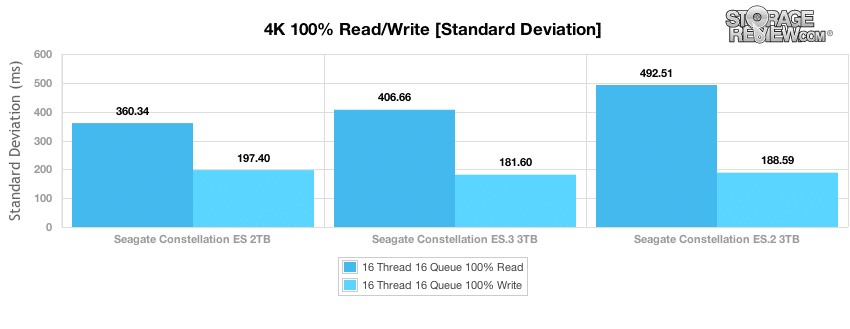
Compared to the fixed 16 thread, 16 queue max workload we performed in the 100% 4K write test, our mixed workload profiles scale the performance across a wide range of thread/queue combinations. In these tests we span workload intensity from 2 threads and 2 queue up to 16 threads and 16 queue. In the expanded 8K 70/30 test, the Seagate Constellation ES.3 had the highest measured performance, offering substantial improvements over both prior-generation models. At 2T/2Q performance measured 122 IOPS, which peaked at 217 IOPS at 4T/16Q.
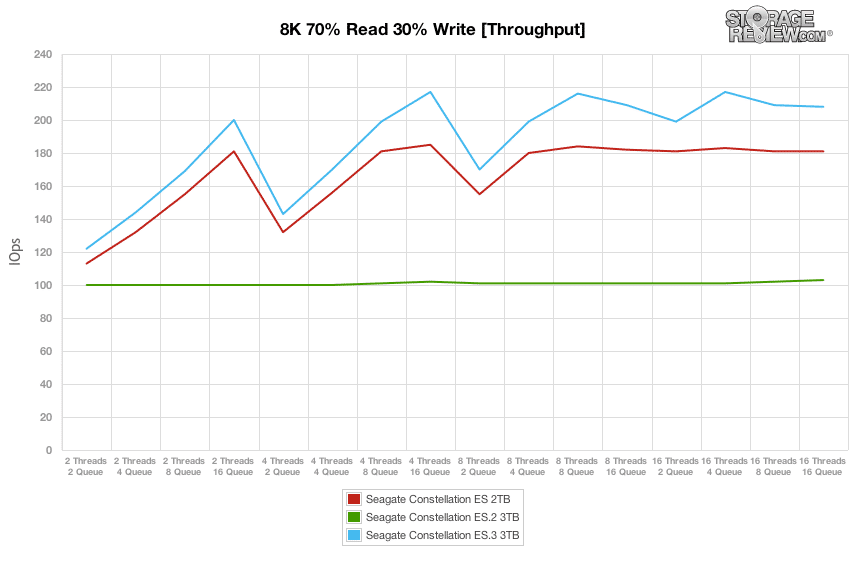
The Constellation ES.2 offered the lowest average latency in the group, ranging from 32.76ms at 2T/2T up to 1,218ms at 16T/16Q.
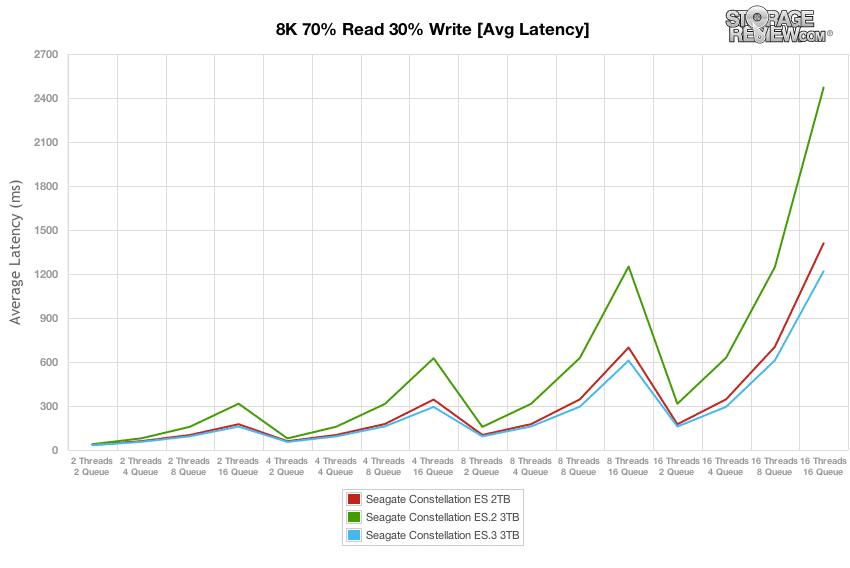
Comparing peak response times in our 8K 70/30 workload, the Constellation ES.3 ranked middle of the pack with workloads with less than 16 threads, and then offered the lowest peak response times when tested with more than 16 threads.
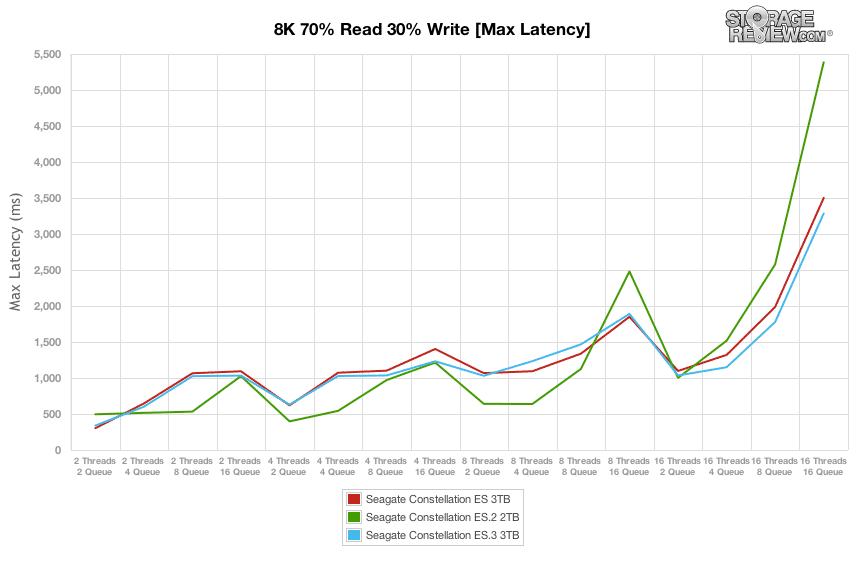
Looking at latency consistency between each model, the ES.3 had a small edge over the ES, although the ES.2 had a strong lead in this category.
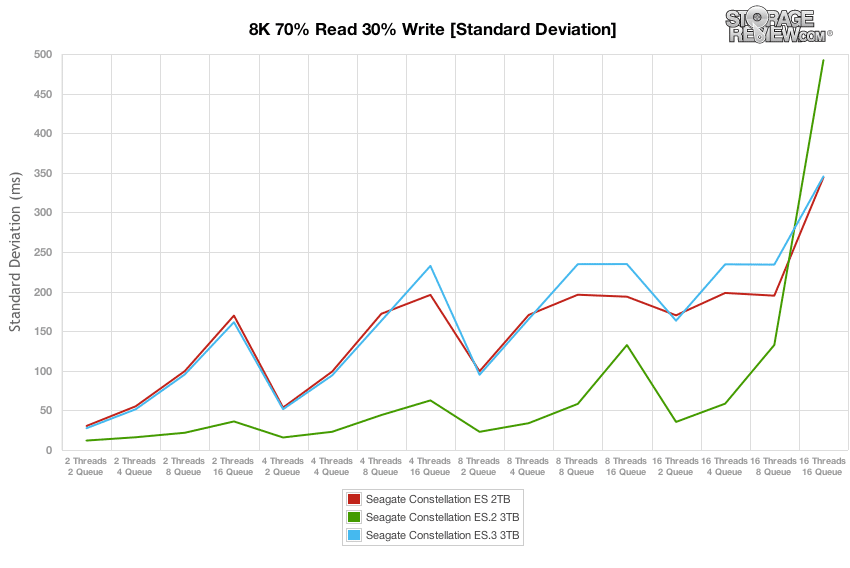
Our next test measures sequential read and write performance with a 128k transfer. With a load of 1T/4Q we measured read speeds of 179.8MB/s from the Constellation ES.3, which is up 12.7% from the ES.2. Looking at sequential write performance, we measured 179.3MB/s, which was up 14.2% from the ES.2.
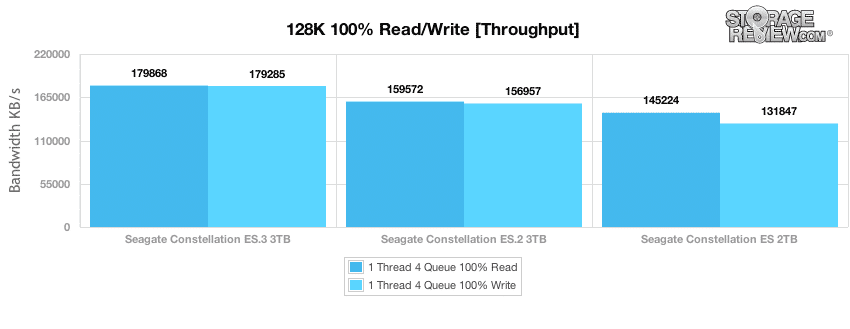
In our next test we look at performance in our File Server workload, which consists of transfer sizes ranging from 512-byte to 64K from loads of 2T/2Q up to 16T/16Q. In this section the Constellation ES.3 showed strong signs of improvement from the ES.2 and ES, dominating across the entire spectrum.
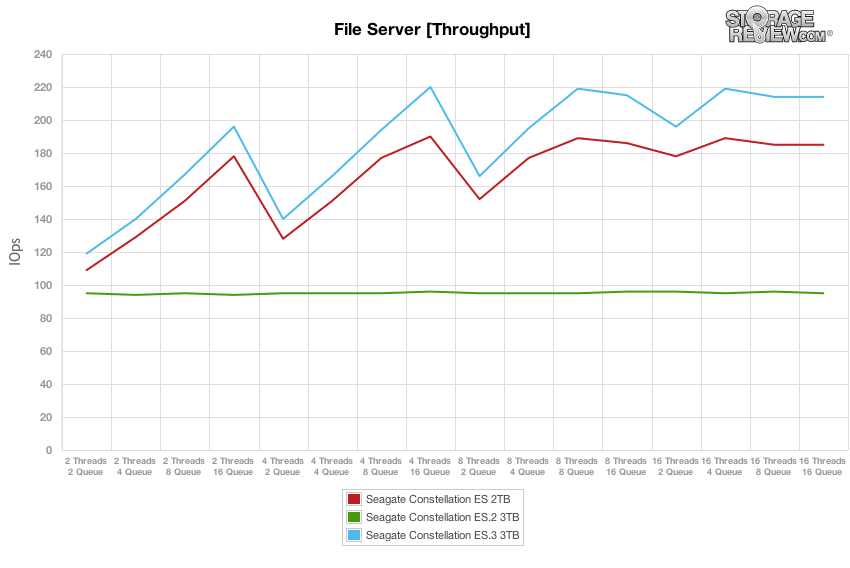
Looking at average latency in our File Server workload, we measured latency scaling from 33.41ms at 2T/2Q up to 1,189ms at 16T/16Q.
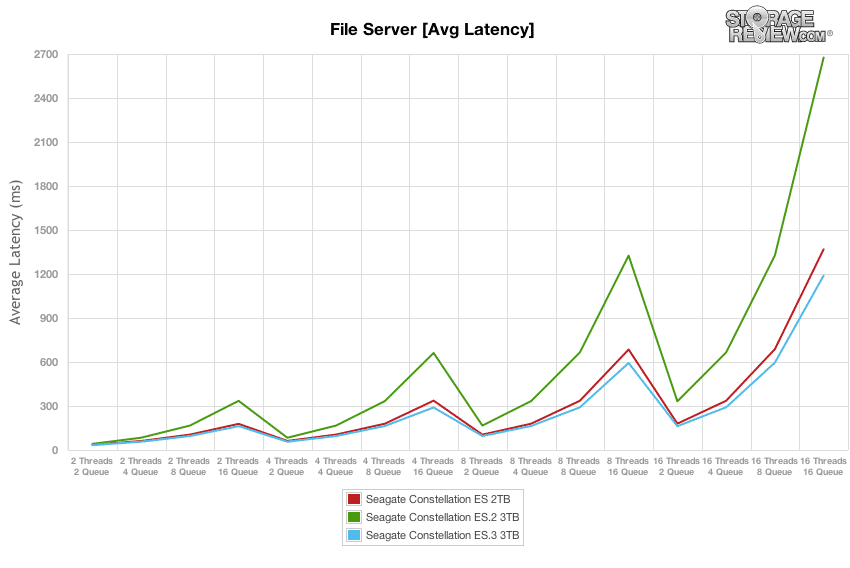
Comparing max latency between the different generations of Seagate Constellation HDDs, the ES.3 ranked middle of the pack, trailing the ES.2 which had lower peak response times.
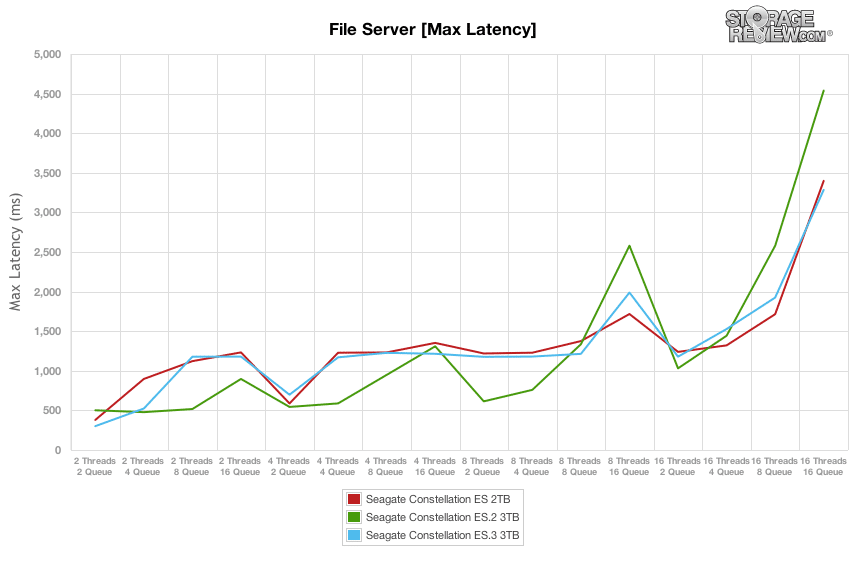
Switching from peak response times to latency consistency in our latency standard deviation chart, the Constellation ES.3 trailed both the ES.2 and ES models, with the ES.2 ranking the best across all loads.
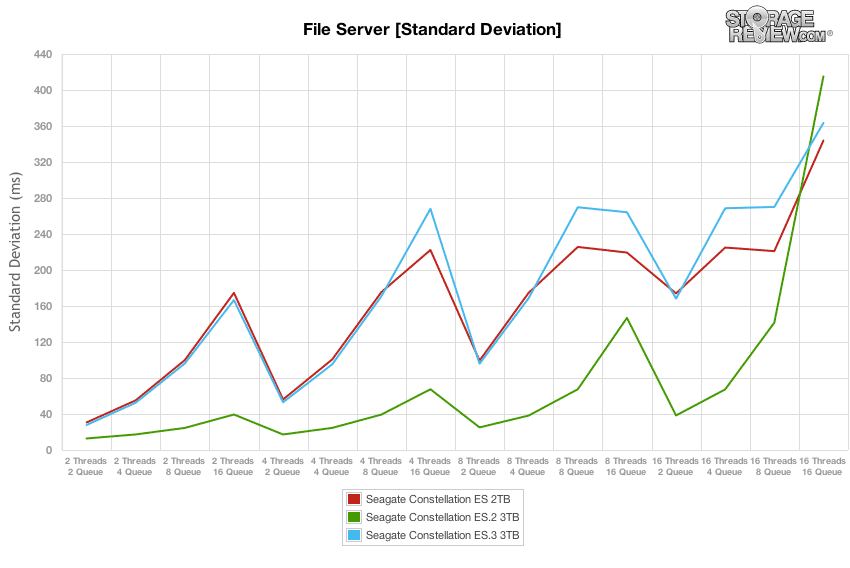
Our last test measures performance in a profile based on Web Server activity, which is setup to be read-only. In a measure of mixed 100% read performance with transfer sizes ranging from 512-byte to 512K, the Constellation ES.3 dominated the pack again, offering a substantial lead over the previous-generation models.
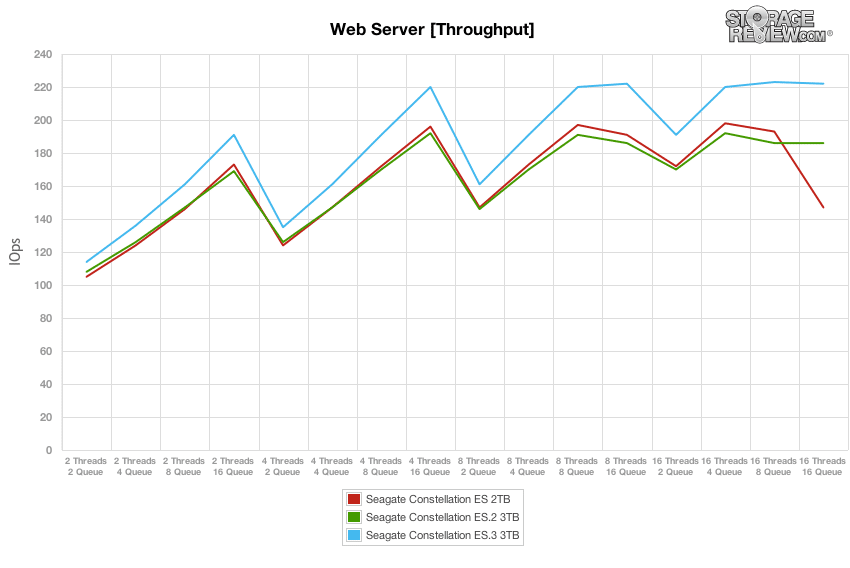
In our Web Server test, average latency ranged from 34.87ms at 2T/2Q which scaled up to 1,151ms at 16T/16Q.
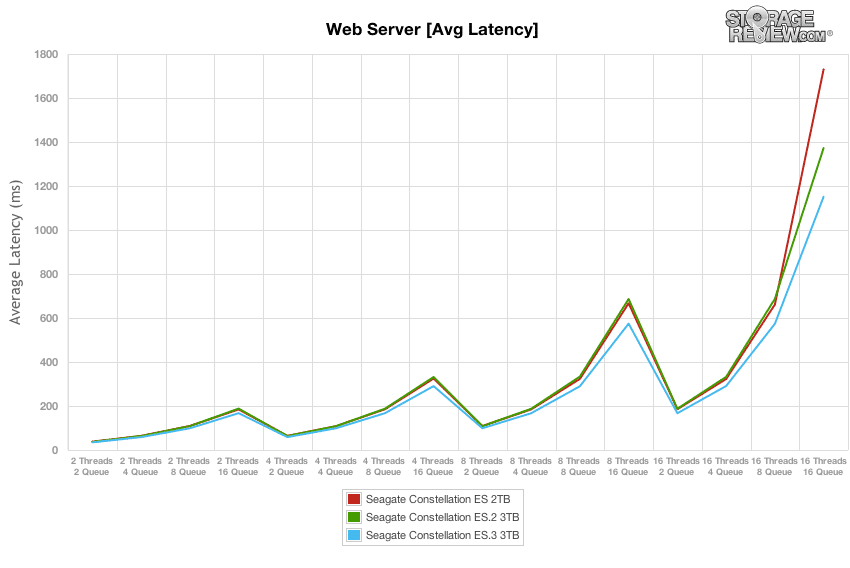
With a workload geared towards read activity, the Constellation ES.3 found its footing, having the lowest peak latencies in across most loads.
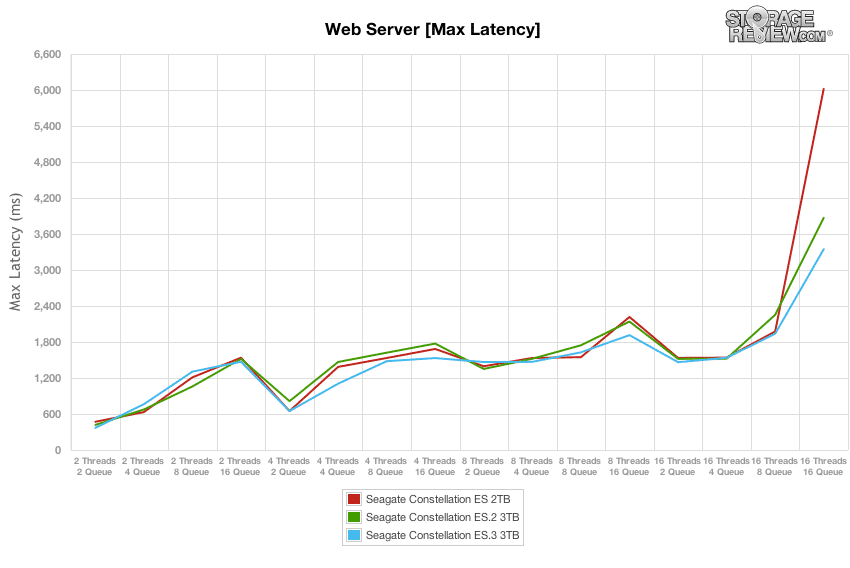
Similar to the improvement we noted in Web Server max latency, the ES.3 also had much better latency consistency in our read-only profile which led the pack from low to higher workloads.
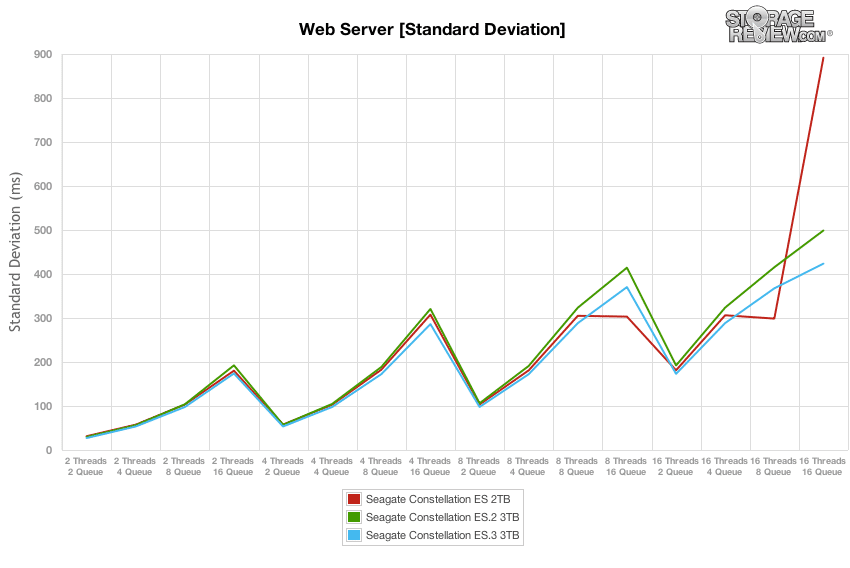
Conclusion
The Seagate Enterprise Capacity 3.5" hard drive line offers the top available capacity of 4TB, with several options ranging from SATA or SAS interface, to SED and FIPS security (SAS model only). The Constellation ES.3 also gets a bit of a performance upgrade over the ES.2 as well. Seagate quotes a 13% throughput gain; we saw a write improvement of 14.2% and a read increase of 12.7% in 128k sequential tests. Across the rest of our benchmarks we more or less found the ES.3 to top the prior generation drives in every test, showing Seagate has been able to eek out just that much more performance out of the platform that now offers 25% more capacity to boot.
With such a big improvement over previous-generation Constellations, it’s hard to find a negative comment about the ES.3. Getting really picky, the max latency and latency standard deviation were a bit higher than we would have hoped, but given the massive speed benefit it might not play a huge role in environments which these drives are put into production.
Pros
- Faster than previous models in every single workload
- Top capacity in the Enterprise SAS 7K class
- Offered in both SAS and SATA interfaces
- FIPS and SED security options
Cons
- Higher latency standard deviation in mixed workloads over ES and ES.2
Bottom Line
Given the top-side capacity of 4TB, SAS interface, and performance bump over the prior generation drive, the Seagate Constellation ES.3 provides a compelling value proposition in the performance 7,200RPM enterprise hard drive space.


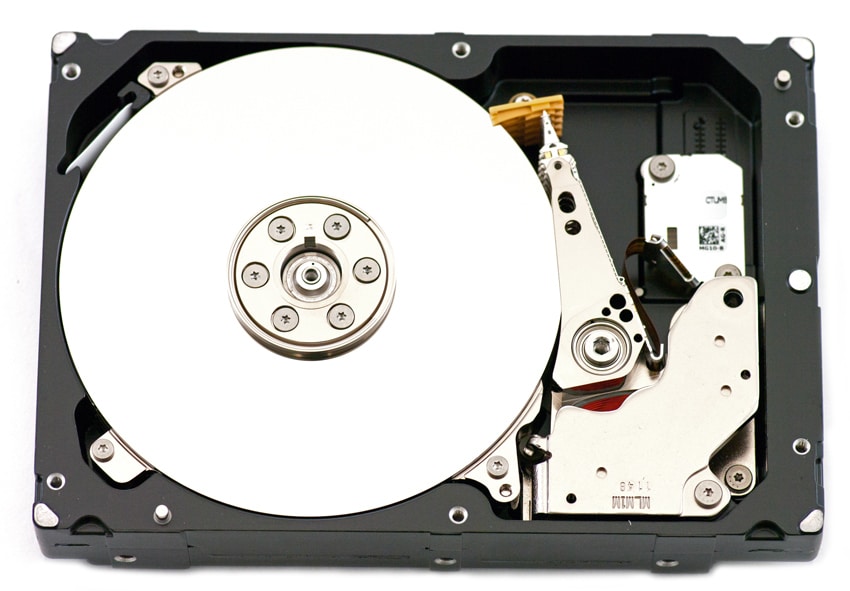
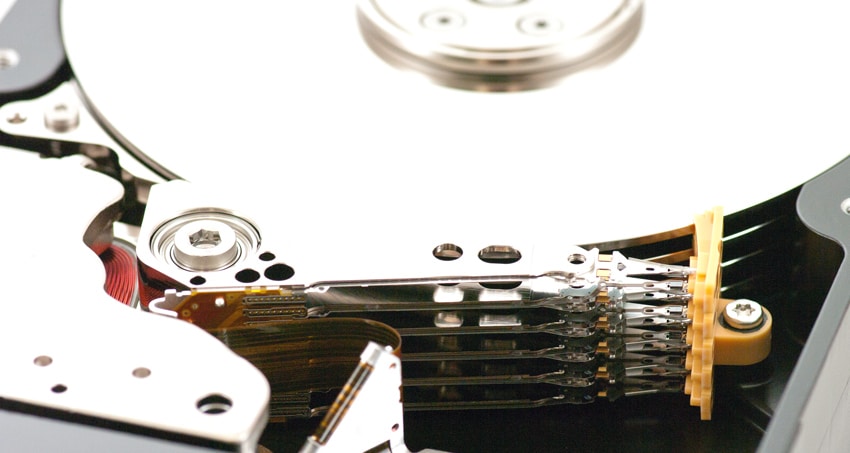


 Amazon
Amazon